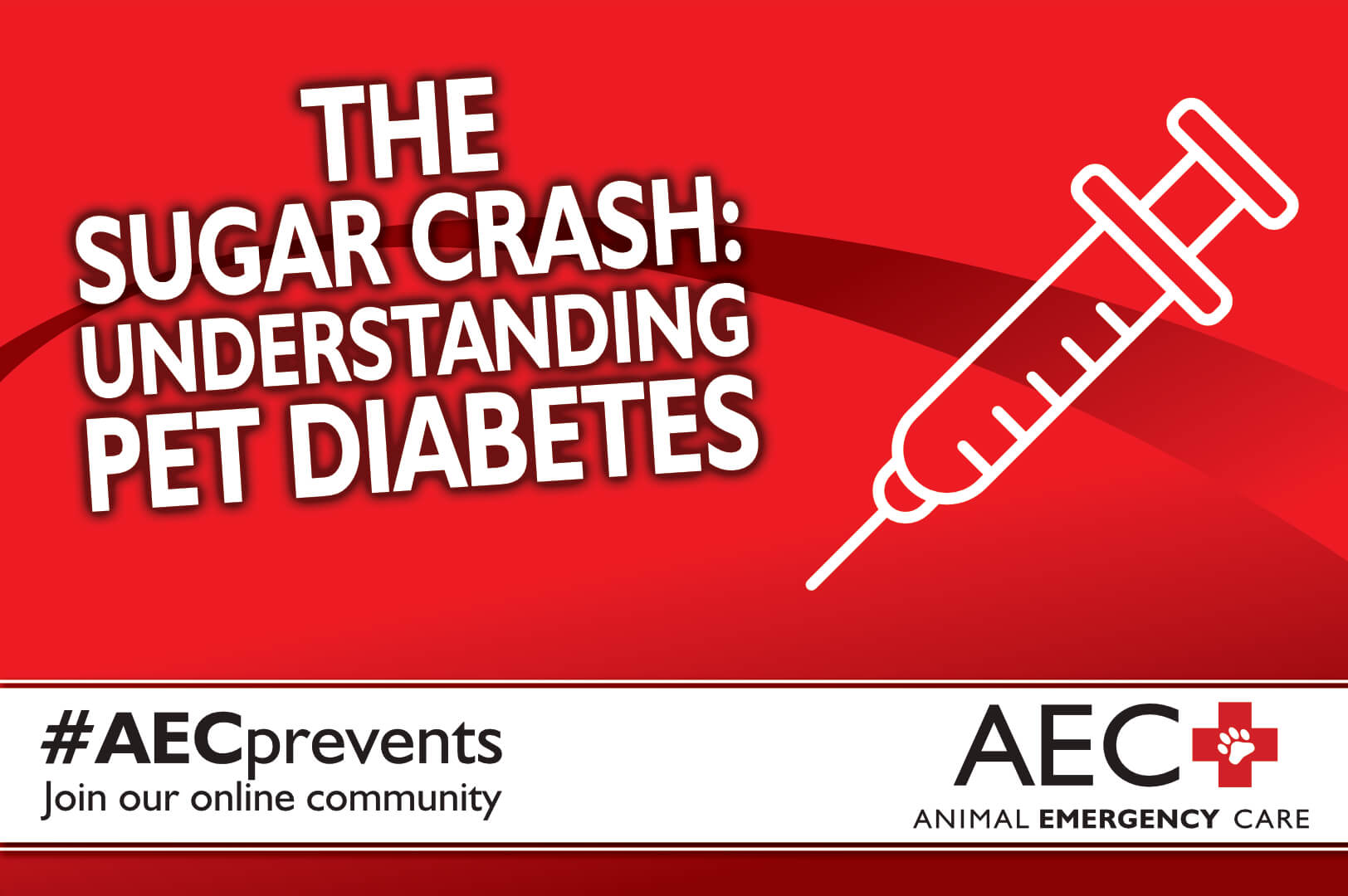It is not uncommon for pets to mimic their owner’s expressions, moods, or love for the same delicious treats. Our pets are family and naturally we want to share all of life’s joys including sweet treats with them. However, too much of a good thing can be dangerous for pets, and can increase their risk of developing health problems such as heart disease, pancreatitis, obesity, or diabetes. Our Animal Emergency Care team describes diabetes signs, treatment, and prevention for your pet.
What is diabetes in pets?
Diabetes mellitus (i.e., sugar diabetes) affects one in nearly 300 cats and dogs. In rare cases, pets also may develop diabetes insipidus (i.e., water diabetes), a condition caused by an abnormally functioning pituitary gland. Diabetes mellitus is the most commonly diagnosed diabetes type in pets, and occurs when the insulin-producing cells of the pancreas do not function properly. Insulin is required for sugar (i.e., glucose) absorption in the body, which is vital for energy and overall organ function. Pets who do not produce adequate insulin become hyperglycemic because the sugar is not able to reach their cells and accumulates in their bloodstream and in their urine in some cases. Pets who are diagnosed have an increased risk for secondary bacterial and fungal infections, which can lead to long-term skin infections, bladder inflammation, lung problems, or an inflamed prostate in male pets. Pets who have uncontrolled or undiagnosed diabetes also are at risk for collapse and possible death. Such breeds as Australian terriers, beagles, and Samoyeds have an increased risk for developing diabetes because of a genetic predisposition. Other diabetes mellitus risk factors may include:
- Obesity
- Long-term use of steroid medications
- Adrenal disease, such as Cushing’s disease
- Pituitary disease
Diabetes signs in pets
Disease signs are variable, and pets with advanced forms of diabetes are at risk for life-threatening ketoacidosis (DKA). Diabetes mellitus signs may include:
- Increased thirst
- Increased urination
- Increased or decreased appetite
- Weight loss
- Dull fur coat
- Cataracts in dogs
- Abnormal gait in cats
DKA signs may include:
- Vomiting
- Diarrhea
- Disorientation
- Depression
- Lethargy
- Coma
Diabetes diagnosis and treatment in pets
Bring your pet in for emergency veterinary care if you suspect they have DKA, or bring your pet to your family veterinarian if they are showing signs of diabetes. Diagnosis is based on consistently high blood glucose and glucosuria, or sugar in the urine. Other diagnostic work may include a complete blood count and serum biochemistry test to check for an underlying infection and overall organ function. A urinalysis and urine culture test may be recommended to check for infection. Other diagnostic tests may include hormone level testing and advanced imaging such as an X-ray or ultrasound to check organ structure and function, and for any underlying disease. Your pet’s diabetic treatment may include:
- Insulin injections
- Specialized diet
- Antibiotics for secondary infections
- Regular blood glucose monitoring
- Blood pressure monitoring
Diabetic dogs will require lifelong insulin treatments in most cases. Some cats may achieve remission. Pets who are diagnosed with DKA will require hospitalization for stabilization and treatment which may include:
- Electrolyte monitoring
- Blood and urine glucose monitoring
- Intravenous fluids for dehydration and electrolyte imbalances
- Short-acting insulin injections
- Anti-nausea medications
- Gastroprotectant medications
Financial options for your pet’s diabetes treatment
Diabetes treatment may require your pet to be hospitalized. In addition, your diabetic pet likely will require lifelong insulin injections, monitoring of their blood glucose, and regular veterinary checkups. Such long-term care can result in a larger veterinary bill. Fortunately multiple payment options are available to help you pay for your pet’s diabetic treatment. Pet health insurance providers like Trupanion offer policies that can pay your veterinary clinic directly, which eliminates the need to submit paperwork and wait for reimbursements. Care Credit and Scratch Pay allow you to spread payments over longer periods with delayed interest rates in some cases. Pet health savings accounts and short-term loans are also available to help.
Diabetes prevention in pets
Diabetes cannot always be prevented in pets. However, feeding your pet a well-balanced diet, ensuring they receive regular exercise, and helping them maintain a healthy weight will decrease their chances of becoming sick. Yearly or more frequent veterinary visits will ensure an early diabetes diagnosis and aid in the identification of underlying medical problems or diabetic risk factors.
Call your family veterinarian if you suspect your pet has diabetes. However, call Animal Emergency Care if your pet has any diabetes or DKA signs after hours, and bring them in for immediate care. #AECprevents
Sources:
https://veterinarypartner.vin.com/default.aspx?pid=19239&id=4951506
https://www.petmd.com/cat/conditions/diabetes-dogs-and-cats-everything-you-need-know
https://veterinarypartner.vin.com/default.aspx?pid=19239&id=4952917
https://www.avma.org/resources/pet-owners/petcare/diabetes-pets


